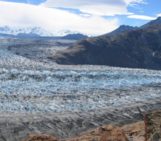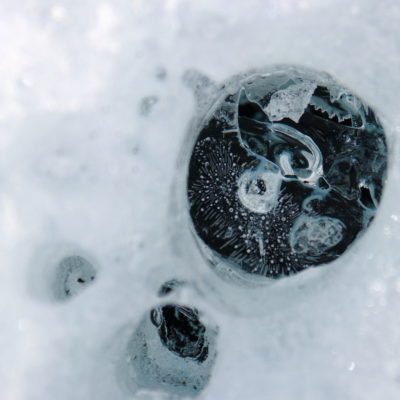
Recent studies show that glaciers are significantly affected by pollution, and in general by human activities, but few people would imagine that their surface contains traces of nuclear contamination and radioactivity. It has been recently claimed that high amounts of radioactivity have accumulated on glaciers, only beaten by the radioactivity levels of sites where nuclear incidents and tests have occurred. How does this work and with what implications? This is what we’ll be looking into today!
Cryoconite: a multidisciplinary research
When you look at a glacier from afar, its white colour makes it appear clean and uncontaminated. However, things change when you get closer. Walking on a glacier, especially in the summer, you realize that its colour is far from being white because of the dirt present on the surface of the ice. The name of these dark sediments that accumulate on glaciers is cryoconite. Cryoconite forms worldwide on the surface of glaciers during the summer (i.e. melt) season and results from the interaction between meltwater, mineral debris and microorganisms. Despite being described almost 140 years ago (Nordenskiöld, 1883), it remained a very under-studied field of scientific research for years. Then, a few decades ago, the attention given to cryoconite literally exploded when it was recognized that cryoconite is a hotspot for microbial life on glaciers. Each pond where it usually accumulates on the ice (called a cryoconite hole) is a small ecosystem where a multitude of peculiar organisms coexist and interact with each other. After the biologists’ enthusiasm, it was the turn of the glaciologists to focus on cryoconite. Due to its colour, it was observed that the darkening due to the accumulation of cryoconite accelerates the melt rate of ice through albedo feedbacks, with important consequences for the mass balance of glaciers (i.e. the net positive or negative gain of snow and ice on glaciers, see this blog post for how we study mass balance). Recent studies have also focused on the role of cryoconite in the cycling of various nutrients and minerals in glacial environments. In particular, it has been noted that cryoconite accumulates many diverse pollutants, such as heavy metals, organics and pesticides. But among the observed substances, radionuclides (the technical term used for a radioactive substance) are by far the ones which present the highest and most unexpected concentrations. Studies from different regions of the world show that the radioactive content of cryoconite is hundreds of times higher than the typical values found in soils and sediments, with cryoconite radioactivity sometimes exceeding 10,000 Bq Kg-1. To put these numbers in perspective: if you measured the radioactivity of the soil from your own garden, you would find radioactivity spanning between 10-100s Bq kg-1. Only sites where nuclear incidents and test explosions have occurred present a radioactive contamination that is higher than that of cryoconite!
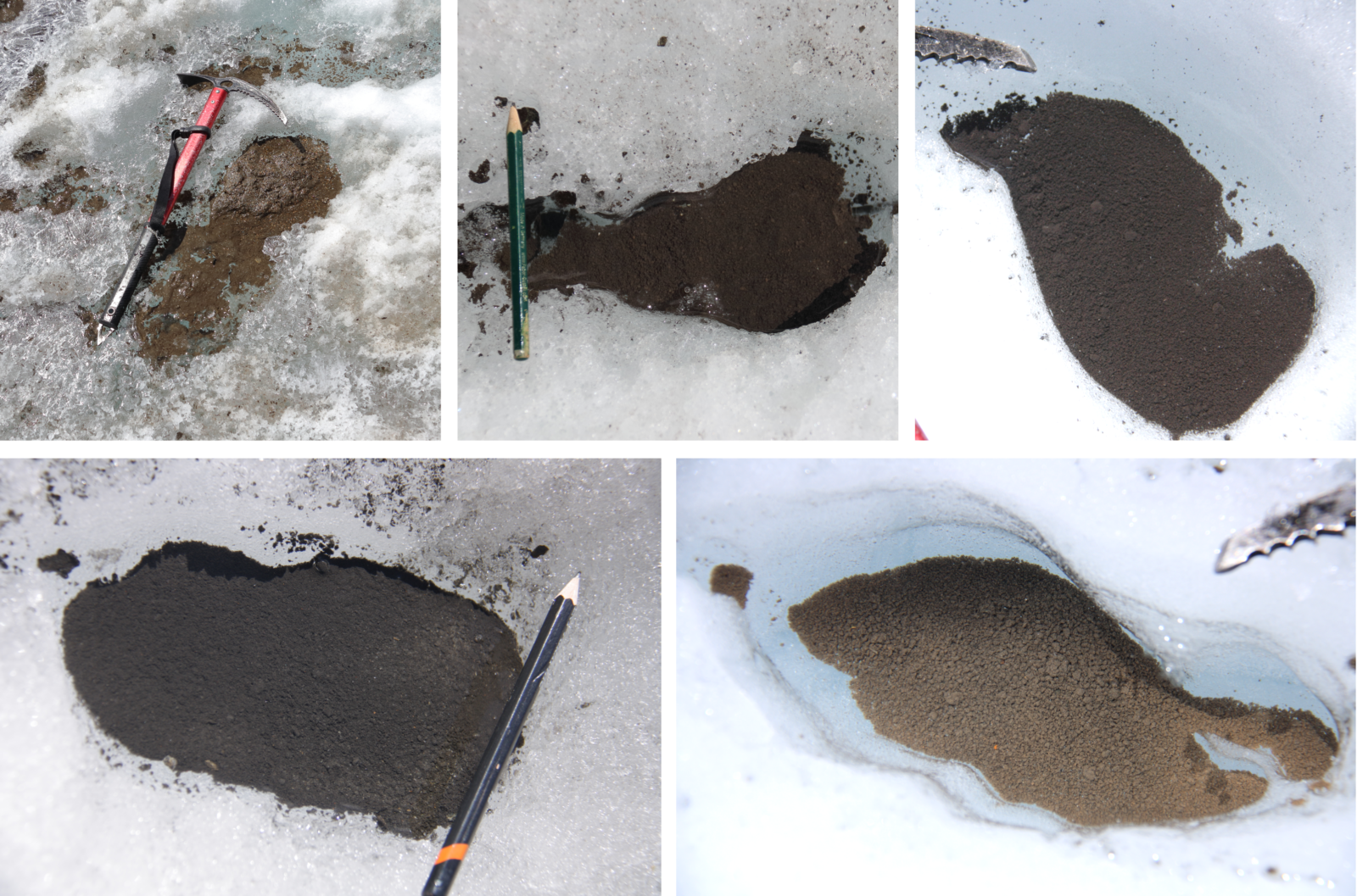
Cryoconite holes in Alpine glaciers. The colour of cryoconite is strictly related to the concentration of organic matter content: the darker the shade, the more abundant the organic matter. Photo credit : Giovanni Baccolo
Early studies of cryoconite radioactivity
The first report on the anomalous concentration of radioactivity on the surface of glaciers, and in their proximity, dates back to 1963 when a pioneering study (Osburn 1963, a difficult to access paper, see the “Further Reading” section for details) was published on the radioactivity of the sediments present on the snow surface. The paper highlighted that the radioactivity found in such contexts was significant. However, in 1963, the atmosphere was much more radioactive than at present because of the nuclear tests ongoing in the context of the Cold War. The radioactive contamination of the Earth’s surface was thus much higher at the time, including the snow and ice deposited on the ground, which might explain why this first study didn’t raise much attention, and research on cryoconite radioactivity was forgotten for more than thirty years.
However, interest rekindled in the last couple of years with a number of new publications on the radioactivity of cryoconite in different regions of the world.
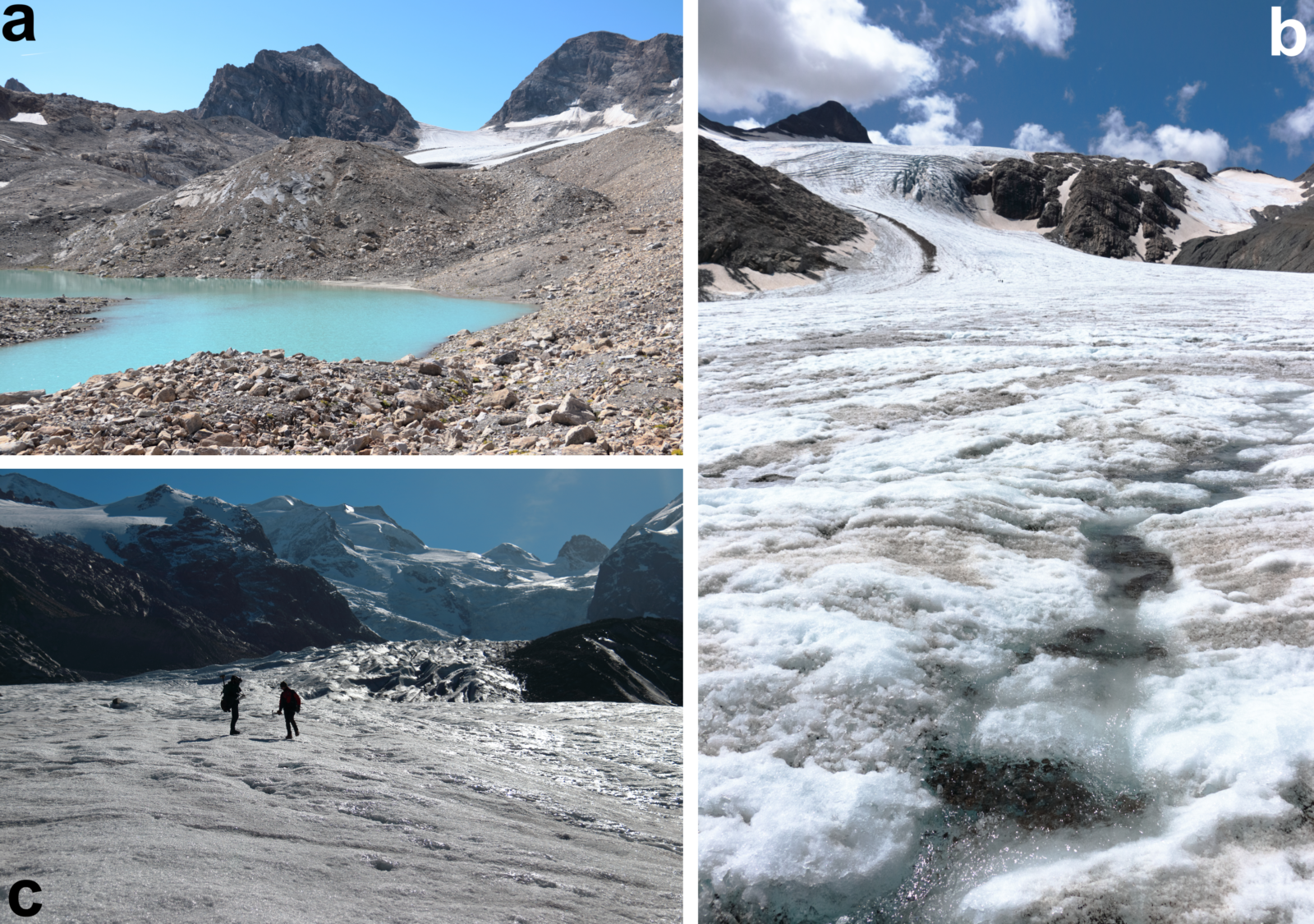
Some of the Alpine glaciers where I have sampled cryoconite to measure its radioactivity: a) Tsanteleina glacier (Graian Alps); b) Gries glacier (Leopontine Alps); c) Morteratsch glacier (Rhaetian Alps). Photo credit : Giovanni Baccolo
Radioactivity in cryoconite: what are we talking about?
Most of the evidence on the radioactivity of cryoconite comes from Alpine studies, but a number of studies have also been carried out in the Caucasus, Svalbard, Maritime Antarctica and Arctic Sweden, suggesting that the radioactive property of cryoconite is characteristic and does not depend on geography. When talking about radioactivity, we often think of the Chernobyl or Fukushima power plant incidents, forgetting that radioactivity is also a natural phenomenon. Radioactivity is naturally present in the environment, as well as within our bodies. So, how we should interpret the presence of radioactivity in cryoconite?
Environmental radioactivity is related to the following classes of radionuclides (radioactive substances): (1) primordial radionuclides (which remain from when the Earth formed, and mostly consist of uranium, thorium and potassium), (2) the ones belonging to the decay chains of uranium and thorium, (3) cosmogenic radionuclides (produced high up in the atmosphere from high-energy radiation) and (4) artificial (man-made) ones. The latter (4) have been spread into the environment over the last eighty years because of nuclear incidents, explosions, atmospheric re-entry of nuclear-powered satellites and re-processing of nuclear waste.
Cryoconite contains mostly types (3) and (4) of radionuclides as only those that spread through the atmosphere (defined as fallout radionuclides) can land on the glaciers to then concentrate into cryoconite. This is not unexpected, since surface environments, including the surface of glaciers, are affected by the deposition of fallout radioactivity (fallout radioactivity is also used by glaciologists to date ice). But the radioactivity is higher in cryoconite in comparison to what is commonly observed in snow and ice, or even in sediments and soils. This suggests that a mechanism must be concentrating radioactivity on the surface of glaciers. Worldwide data show that the fallout radionuclides present with the highest concentration in cryoconite are lead-210 and cesium-137. Lead-210 is the only fallout radionuclide belonging to the decay chain of uranium-238 (it comes from a radioactive gas, radon-222), while cesium-137 is an artificial radionuclide. Cesium-137 results from the splitting of a uranium-235 atom (the fuel adopted in nuclear power plants and in some weapons), and is a common artificial radionuclide present at the surface of the Earth. In addition, many other artificial species have been found in cryoconite, although at lower concentrations. For example bismuth-207, which is related to the Tsar bomb, the most powerful thermonuclear device ever exploded in 1961 in Novaya Zemlya, Russia.
Radioactivity in cryoconite: where does it come from?
It has been possible to constrain the main geographic sources of radioactivity in cryoconite. Alpine cryoconite shows a dominant contribution from the Chernobyl fallout, while in other regions, such as the Caucasus, the radioactivity of cryoconite is more influenced by proximal nuclear test sites, where hundreds of bombs were detonated (in this case Kazakhstan). In Svalbard, non-negligible traces of the re-entry of the SNAP-9 satellite in 1964, powered by nuclear batteries, have been identified in cryoconite.
It seems that cryoconite provides a record of the entire history of radioactive deposition from the atmosphere, both global and local. At present, mainly lichens and mosses are used to monitor the radioactive contamination of the atmosphere. In the future, it would be desirable to therefore also consider cryoconite.
Understanding the process
The last thing left to understand is why cryoconite is so radioactive. To shed light on this, it is necessary to consider how cryoconite forms and its link with the whole glacial environment. Every time it snows on a glacier, the snow that accumulates contains the impurities present in the atmosphere, thus storing them at the surface and then deeper down into the ice as snow continues to fall on top. Glaciers can thus be interpreted as enormous repositories of atmospheric-related substances, fallout radionuclides included. During the melt season, some of the impurities trapped in the ice (including the radionuclides) are picked up and transported with the meltwater at the surface of the glacier. This meltwater travels in seasonal channels that cut into the surface snow and ice. These channels are where cryoconite forms. The accumulation of the atmospheric impurities from the meltwater to the cryoconite is explained by the high amounts of organic matter present in cryoconite (in fact, 5-20% of cryoconite mass consists of organic matter), and the fact that organic matter is extremely efficient in attracting radionuclides. Cryoconite can thus be seen like a sponge that concentrates radionuclides from meltwater. Something similar likely occurs for other atmospheric pollutants, as recent studies show that cryoconite is also rich in pesticides, heavy metals and anthropogenic organics, making cryoconite a good candidate for future studies on the environmental quality of glaciated areas.
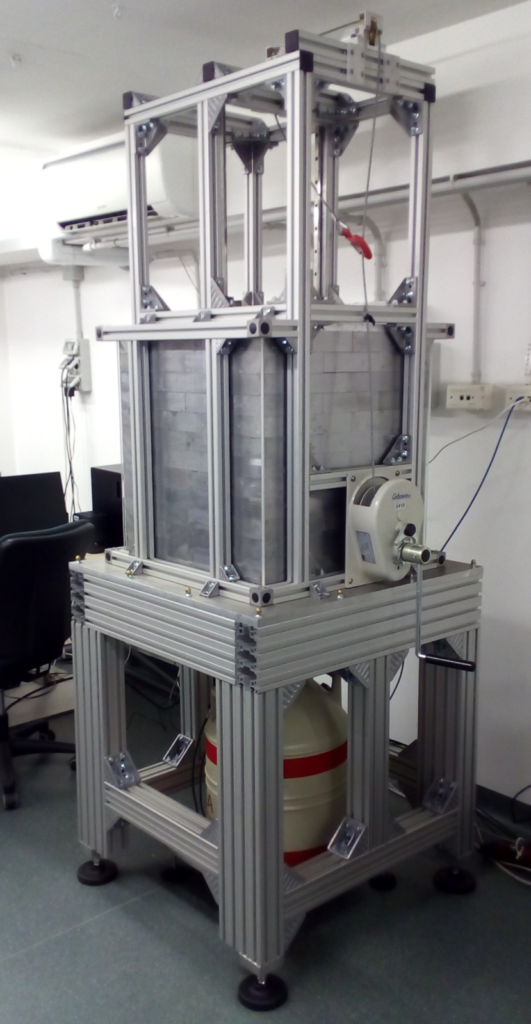
One of the gamma spectrometers used to measure the radioactivity of cryoconite. The lead shield is needed to isolate the samples from the radioactive background of the laboratory. Photo credit : Massimiliano Nastasi
Implications
Many unknowns around cryoconite remain to be solved, but one of the most important ones is whether the radioactive contamination found in cryoconite poses ecological or health risks. The radioactivity observed in cryoconite is among the highest rate ever found in the environment. But we also know that after cryoconite is carried by meltwater all the way down a glacier, it makes it way into the rivers, thus heavily diluting it, and avoiding any health or ecotoxicological risks for the downstream ecosystems.
A different story concerns the areas nearer to the glaciers, where the dilution is limited and a partial accumulation of cryoconite is likely. Further attention should be thus given to the fate of cryoconite in such areas, where fragile pioneering ecosystems are developing as a result of the worldwide shrinking glaciers.
But what about the risk posed to tourists and alpinists? Cryoconite radioactivity can easily exceed the food intake limits imposed by national legislations, but luckily no-one would feel compelled to eat cryoconite… In addition, tourists usually visit glaciers for short periods (not exceeding a few hours) and cryoconite is found in concentrated deposits near the base of glaciers. The exposure to radioactivity because of cryoconite can therefore generally be considered as negligible. Although I would not recommend drinking meltwater from a cryoconite hole!
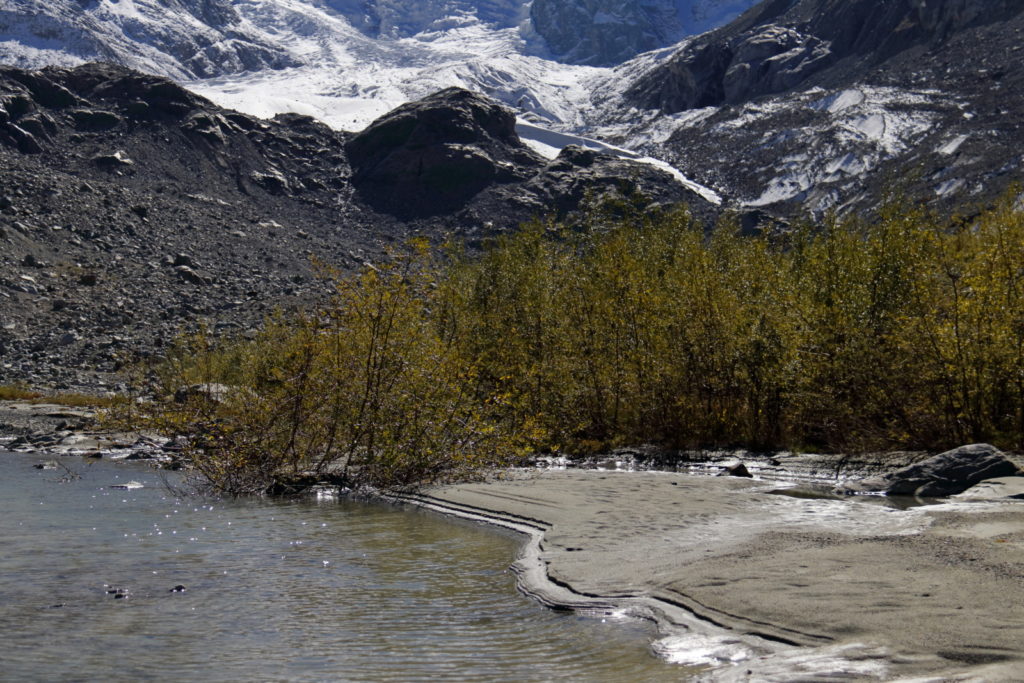
Green alders (a typical tree in cold and nutrient-poor environments) colonize the pro-glacial plain in front of the Morteratsch glacier. Such terrains are the ones which could be most impacted by the accumulation of cryoconite radioactivity from the nearby glacier. Photo credit : Giovanni Baccolo
I guess that the accumulation of radioactivity into cryoconite can teach us something about the complexity of the natural environment. More than half a century ago, it was common practice to test nuclear weapons in the atmosphere. At that time, no one expected that, due to the unique features of glacial environments, the ultimate legacy from those activities would have been maximally concentrated on the surface of glaciers…
Further reading
- G Baccolo et al. 2020. “Cryoconite: an efficient accumulator of radioactive fallout in glacial environments.” The Cryosphere 14, 657-672, DOI: 10.5194/tc-14-657-2020
- G Baccolo et al. 2020 “Artificial and natural radionuclides in cryoconite as tracers of supraglacial dynamics: insights from the Morteratsch glacier (Swiss Alps)” CATENA 191: 104577, DOI: 10.1016/j.catena.2020.104577
- J Cook et al. 2016. “Cryoconite: the dark biological secret of the cryosphere.” Progress in Physical Geography: Earth and Environment 40: 66-111, DOI: 10.1177/0309133315616574
- WS Osburn, 1963. “The dynamics of fallout distribution in a Colorado alpine tundra snow accumulation ecosystem”, pages 51-71, in Radioecology, Reinhold Publ. Co., New York.
- JF Pinglot et al. 1994. “Natural and artificial radioactivity in the Svalbard glaciers” Journal of Environmental Radioactivity 25: 161-176, DOI: 10.1016/0265-931X(94)90013-2
- A Tieber et al. 2009. “Accumulation of anthropogenic radionuclides in cryoconites on Alpine glaciers”. Journal of Environmental Radioactivity 100: 590-598, DOI: 10.1016/j.jenvrad.2009.04.008
- Sarah Emerson: Melting glaciers could unleash nuclear fallout trapped within the ice
- Caroline Clason: The downstream impacts of retreating glaciers on water, food, and energy security: an anthropogenic hangover
Edited by Marie Cavitte
 Giovanni Baccolo is a postdoc at the University of Milano-Bicocca, Italy. He studies glaciers to unveil the environmental and climatic pieces of information trapped within ice and snow. His research is mostly focused on ice geochemistry which he uses to study the climatic significance of mineral dust from ice cores and to investigate supraglacial processes such as the radioactivity of cryoconite. He tweets as @g_baccolo. Contact email: giovanni.baccolo@unimib.it
Giovanni Baccolo is a postdoc at the University of Milano-Bicocca, Italy. He studies glaciers to unveil the environmental and climatic pieces of information trapped within ice and snow. His research is mostly focused on ice geochemistry which he uses to study the climatic significance of mineral dust from ice cores and to investigate supraglacial processes such as the radioactivity of cryoconite. He tweets as @g_baccolo. Contact email: giovanni.baccolo@unimib.it



